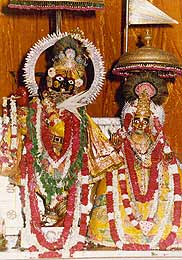 |
Sri Govindaji Deity was originally installed 5000 years ago
by great Krishna's grandson in Vrindavana and it is one of the four
main Deities of Vraja-mandala. Others are Keshavadeva (on Janmasthana),
Harideva (on Govardhan) and Dauji (Deity of Balarama). Govindaji was
worshiped by Srila Rupa Goswami in Radha-Govinda Temple.
|
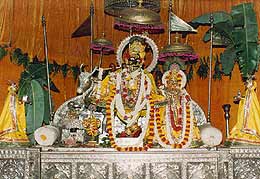 |
...Before that the Deity was for
a long time lost. One day Rupa Goswami had a dream and Govindaji Deity
appeared to him and told him where it is buried. Rupa Goswami discovered
the Deity and personally took care about the worship... |
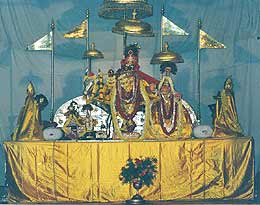 |
...Maharaja Jai Singh II. took
the Deity from Vrindavana to Amber near Jaipur to protect it from Muslim
king Aurangzeb, who used to destroy the Hindu temples and break the Deities.
The Deity was moved to Jaipur in 1728 (or in 1735 according to the other
sources). Maharaja Jai Singh dedicated his Jaipur or "the town of
victory" to Govindaji. |
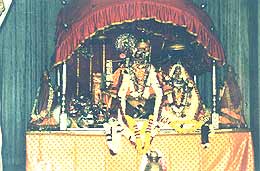 |
Sri Sri Radha-Govindaji. On the
altar there are life size Deities (Radha's Deity is also black). The smaller
Deity of Gaura-Govinda was worshipped by Kasishvar Pandit. Deities are
dressed 3 times a day and Srila Prabhupada considered local Deity-worship
standard to be a good example for others to follow. |
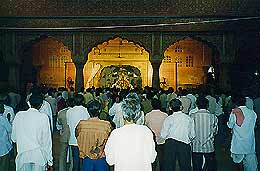 |
Every day before 5 a.m. in the
morning almost 5000 people is coming to see their beloved Deity on mangala-arati. |
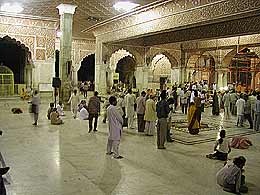 |
Every month the times for the
aratis change, therefore it is important to ask what time arati is. |
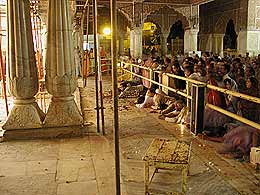 |
The devotees enthusiastically chant prayers in praise of Lord Govinda.
|
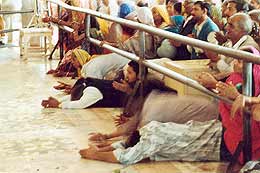 |
The translation to
the mantra that is chanted in front of Govindaji is: "We hunger for
the sight of your face, and we wish to fix you constantly in our thoughts
while meditating on your lotus face. This life is full of responsibilities
and now we are in the middle of the ocean; please give us your blessing
so that we can relieve ourselves of life's burdens and understand the
meaning of life." |
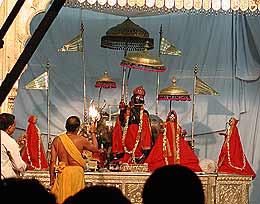 |
Chanting continues
during arati... |
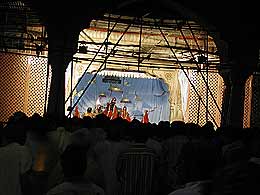 |
...and than people
start to circumambulate Deities and the whole altar. |
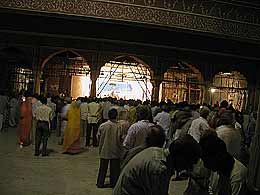 |
Devotional atmosphere in this temple is one of the heights of visit
in Jaipur.
|
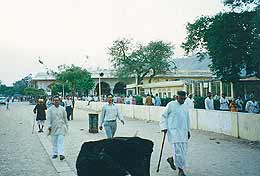 |
Where the temple is everybody will tell you...
The temple is situated inside the palace complex. When the doors of
the altar were open, Maharaja could see the Deity from his private rooms.
|
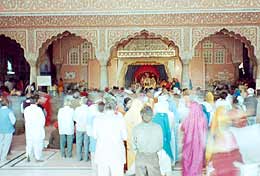 |
There is a local custom that after
the arati devotees usually buy a maha-prasad from priests and distribute
it to other devotees. |
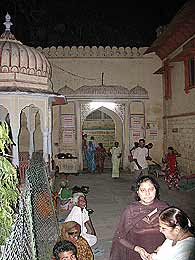 |
One of the entrances
early in the morning. |
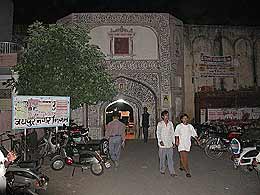 |
One can take rickshaw
to get there. |
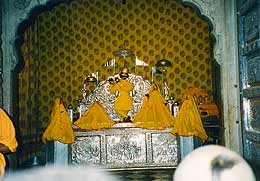 |
Sri Sri Radha
Gopinath Temple
It is said that Vajranabha, Krishna's great-grandson, had three Deities
of Krishna carved. He never saw Krishna, so the Deities were carved according
to the description given by Uttara, the mother of Maharaja Parikshit.
He had three different images carved, but none of them were perfect...
|
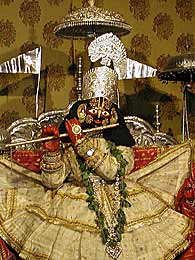 |
...Govindaji resembled
Krishna's face (Mukharavinda), Madana-Mohan resembled Krishna from the
navel down to the lotus feet, and Gopinatha resembled Krishna from the
navel to the neck... |
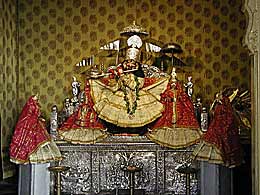 |
In one book about
the temples of Vrindavan, the Padma Purana is quoted saying that to get
the full vision of Sri Krishna, pilgrims have to visit and offer obeisances
to all three Deities during a single day, while the sun is still up. Sri
Govinda and Sri Gopinatha are now in Jaipur, and Madana-Mohan is in Karoli,
a small town in Rajasthan 182 km from Jaipur. |
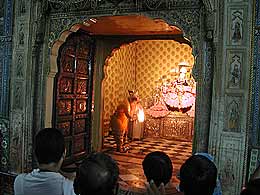 |
Gopinath was worshiped
by Madhu Pandit Goswami and discovered at Vamsivata in Vrindavan by Paramananda
Bhattacarya, the disciple of Gadadhar Pandit. Vajranabha originally installed
Gopinatha in Vrindavan. |
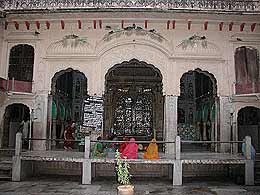 |
Gopinath is "Lord of the Gopis" and His hands playing flute
are enchanting not only for the gopis but for ordinary devotees as well.
|
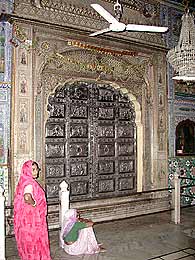 |
This temple has beautiful
carved silver doors. |
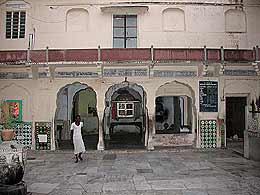 |
A unique embroidered
tulasi-bead jacket and tulasi japa beads, both of which belonged to Madhu
Pandit, are displayed in the courtyard. |
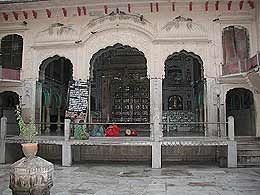 |
Temple room in daylight.... |
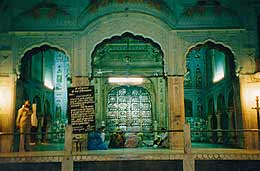 |
...and at night. |
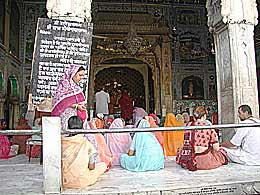 |
As in many temples
one can get delicious prasadam after arati - usually laddus and sweets. |
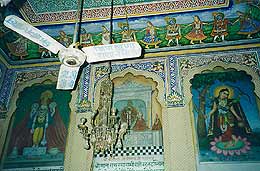 |
There are beautiful
paintings on the walls. |
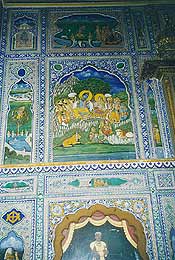 |
On the ceiling there are paintings
of the rasa-lila.
|
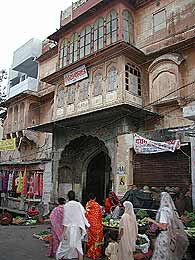 |
The temple is located
in the Topkhanadesh area of Jaipur by Chandpol Bazaar. If you are on Tripoliya
Bazaar Road, you go west until you get to Gangori Bazaar Road. Tripoliya
Bazaar Rd is the main road, right next to the inner wall. You make a right
and go down a few streets and then you make a left and go about a half-km
down the road. The temple is on the left. |
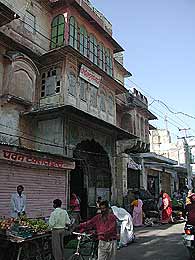 |
But still it easy
to pass by without noticing it. It is better to have a good guide. |
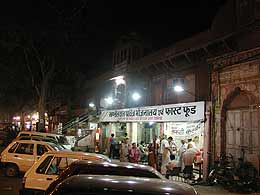 |
Radha Damodar
Temple
Coming from Tripoliya Bazaar Rd, the temple is located about 60m (200
ft) down Chaura Rasta Rd on the right side. It is about a ten-minute walk
to here from the Radha-Govinda temple. |
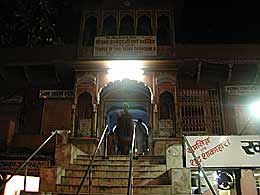 |
You will climb few
steps, enter the gate with the sign "Temple of Sri Radha Damodar
Ji"... |
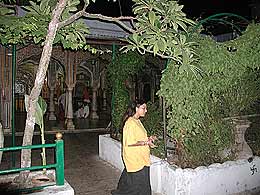 |
... and there you
are in another world. |
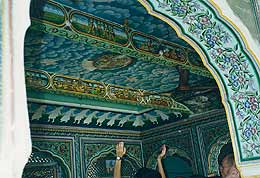 |
There are also nice decorations on the walls.
|
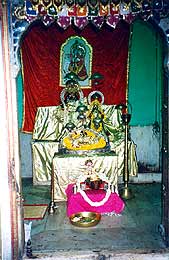 |
There are two sets of Deities on the main altar. |
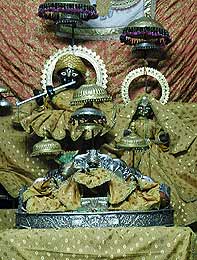 |
The smaller set of
Deities is Jiva Goswami's original Radha Damodar Deities from Vrindavan.
To the left of the Deities is a Govardhan-shila said to have been worshiped
by Sanatana Goswami.
|
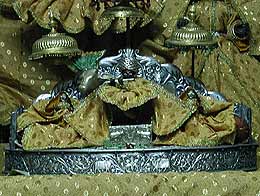 |
Original Radha Damodar
Deities. |
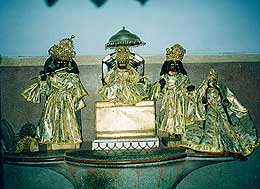 |
On an altar, left of the main
one, there are Deities of Lakshmi Narasimha and Prahlada Maharaja. You
have to look closely to see Prahlada Maharaja. |
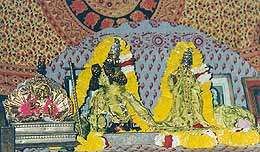 |
Vinodilal Temple
This is a small temple up some stairs on Tripoliya Bazaar Road. Vinodilal
was installed by Lokanath Goswami. He was the first devotee sent to Vrindavan
by Sri Chaitanya. He has one famous disciple, Narottama dasa Thakur, who
was a great poet and who composed many beautiful Vaishnava songs in praise
of the Lord. |
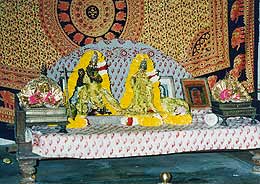 |
Vinodilal is a beautiful Deity
about 30 cm (12 inches) tall. It is a very difficult temple to find, as
few people come here. From the Radha Damodar Temple you walk to Tripoliya
Bazaar Road and make a left. Walk 50 big steps and you will find a flight
of stairs to your left. To the right of the stairs is a hose shop, which
is shop number 295. If you look at the building, it will not look like
a temple. The temple is situated one flight up.
|
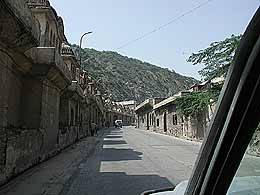 |
Jaipur was built
by and named after Maharaja Jai Singh II (1699-1744). In 1727, Jai Singh
decided to move down from the fortified stronghold of Amber to build a
city on the plains below. Before the city of Jaipur was built, the kingdom
was known as the Amber kingdom. The city was built according to the Shilpa
Sastra, an ancient Hindu composition on architecture. The city was
laid out with six blocks surrounded by a city wall. The city streets are
wide. |
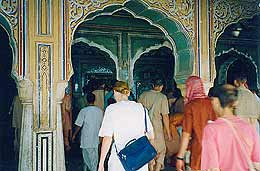 |
When one enters this city, one
is charmed by the old-world, picturesque atmosphere. |
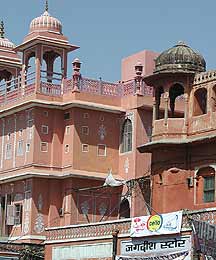 |
Many of the buildings within the
walled city are painted pink. Hence the city is known as the "Pink
City." |
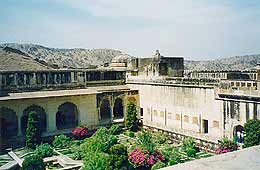 |
Jaipur City Palace and Museum
Jai Singh built this palace located in the middle of the old Pink City
between 1729-32. It is huge, but much of the palace cannot be visited
because it is used as the home of the current Maharaja, Sawai Bhawani
Singh.
|
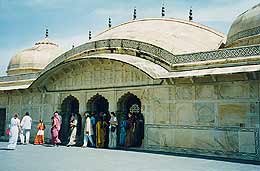 |
Big exposition of
arms inside the fort documents the military strength of local Rajas (kings).
The sword of Maharaja Man Singh, the 17th century king of Jaipur, weighs
about 5 kg (11 lb). The palace was opened to tourists in the 1950s. Over
400 films have been shot here. |
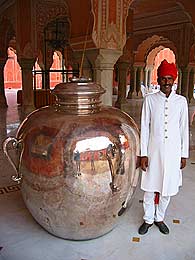 |
There are two large,
1.5m high Gangajalis, silver containers that were made to hold a large
amount of Ganges waters so that the Maharaja of Jaipur could take it on
a trip to England. Each container weights 345kg and holds 9,000 liters
of water. A sign says that the Guinness Book of Records claims they are
the biggest pieces of silver in the world. |
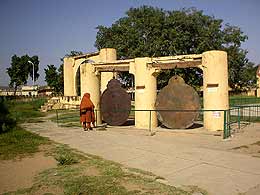 |
The palace has seen
many important visitors, including Queen Elizabeth II, Jawaharlal Nehru,
the King of Nepal, Jacqueline Kennedy, and the Shah of Iran. It is an
interesting place that takes an hour or two to see. The Radha-Govinda
Temple is next to the palace. |
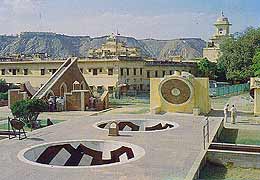 |
Jantar Mantar
Across from the City Palace is a large observatory built by Maharaja Jai
Singh in 1728. It is the largest stone observatory in the world. |
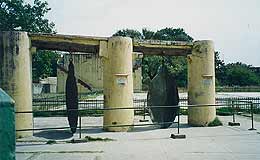 |
Jai Singh also built
observatories in Delhi, Varanasi, and Ujjain. |
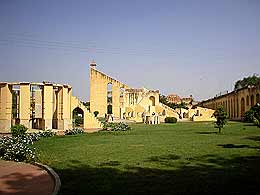 |
There are eighteen
gigantic instruments in the observatory. |
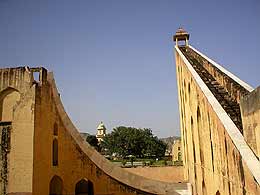 |
Each instrument is
used to make intricate astronomical calculations. Without a guide (Rs
50) you will have no idea what most of them are. |
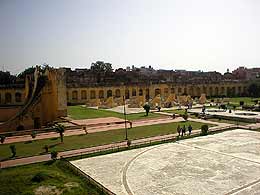 |
One of the most interesting
instruments is the sundial (Samrat Yantra), which has a gnomon (slanted
centerpiece) 27m (90 ft) high. The time is accurate within two minutes. |
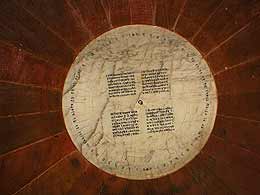 |
Before building
this observatory, Jai Singh sent scholars around the world to study the
observatories in other countries. |
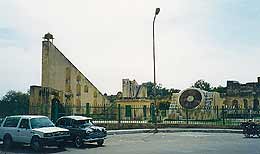 |
|
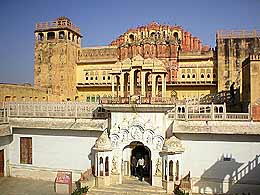 |
Hawa Mahal (Palace
of the Wind)
This five-storey pink, sandstone building, built about 1799, is a major
tourist site. It has hundreds of screened windows and small balconies.
It was built by Raja Sawai Pratap Singh to allow the royal ladies to overlook
the city, as they were usually confined to the zenana quarters. |
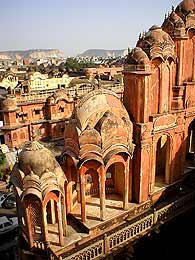 |
This mahal enabled
them to climb to the top and get a good view of the city. It is also said
that the Maharaja had the Hawa Mahal built so he could have a nice place
to write devotional songs about Govindaji (Krishna). There is an interesting
view from the top floor, and the place is interesting to walk around. |
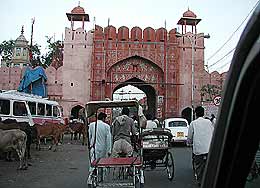 |
The city was laid
out with six blocks surrounded by a city wall. |
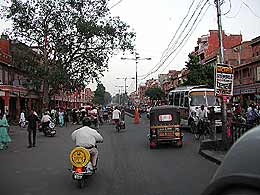 |
Streets... |
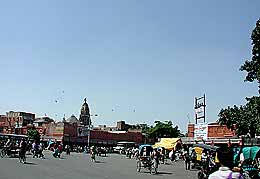 |
...and temples of
"pink city". |
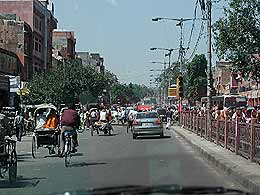 |
Since Jaipur is city
sought after by tourists, it is one of the most expensive ones in all
India. |
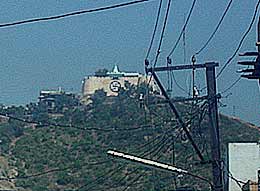 |
For the people from Central Europe Ganesha's Temple on the top of the
hill above the city may create strange associations in the mind. We
started to call it "Hitler's headquarters”, but of course, we shouldn't
forget that swastika is traditional Vedic symbol and Hitler just borrowed
it and modified it for his own purposes.
|
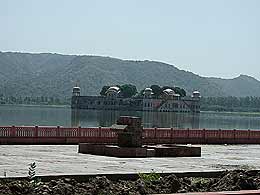 |
Lake near the city.
|
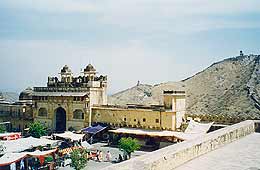 |
Nahargarh Fort (Tiger Fort) was built in 1734. The fort overlooks
the city of Jaipur and is floodlit at night. You can wander around the
fort and get lost in time. There is an outstanding view of the valleys
below. You get to the fort by taking a winding 8 km road from Jaipur.
It is a difficult 2 km walk up from the northwest part of the city.
|
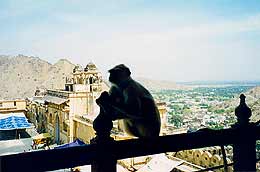 |
One can see monkeys
there... |
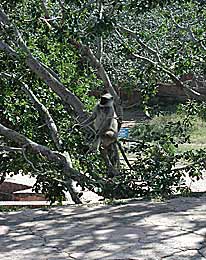 |
....but not like in Vrindavan, local monkeys are more friendly...
|
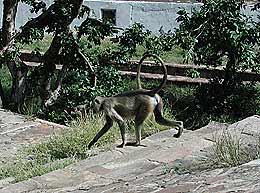 |
...They are called
"Hanumans" and they have really funny movements. |
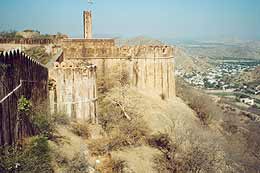 |
Jaigarh fort (Amber) was built in 11. century. Amber, or Amer,
was formerly the capital of the Rajput Kachhwaha dynasty before it was
moved to the city of Jaipur. The Kachhwaha dynasty ruled this area from
the 12th to the 18th centuries. Jai Singh decided to move down from
the fortified stronghold of Amber to build a city on the plains below.
|
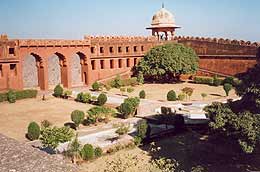 |
King's residence
in eastern part of the forth. |
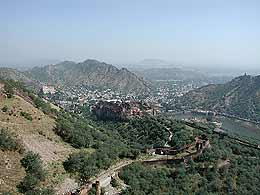 |
The sight of Maharaja's palace
from the fort... |
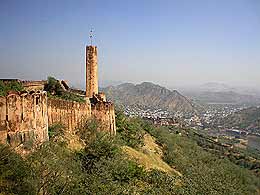 |
...where Amber palace and Amber city lies.
|
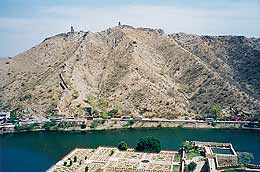 |
...lake bellow the
fort, next to palace. |
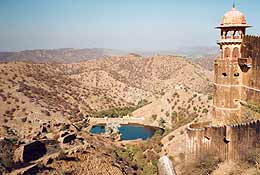 |
|
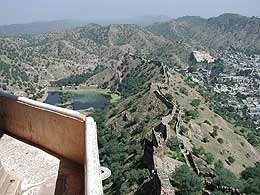 |
The walls resemble
the Great Chinese one. |
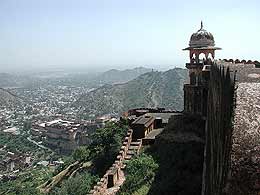 |
While walking on huge Amber Fort and looking on the walls on the hills
on opposite sides one starts to realize why Muslims never defeated Rajput
kings and Jaipur city.
|
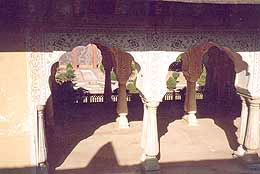 |
And the kings were supposedly
ruling their subjects rightly and therefore their armies were determined
and chivalrous while fighting for their king. |
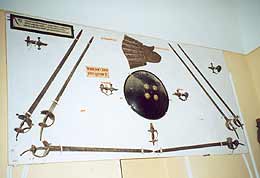 |
In the fort there is big exhibition of arms. It is because of great
military strength of Rajas, that many of the Vrindavana's Deities were
protected from Muslim invaders. There is a large collection of old weapons
here dating from 1580 onwards. There are daggers whose handles contain
secret chambers, and gunpowder holders made from seashells.
|
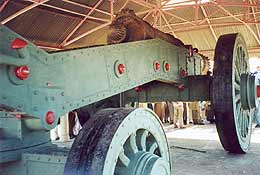 |
The huge, fifty-ton Jai Ban cannon is said to be the largest cannon
on wheels in the world.
|
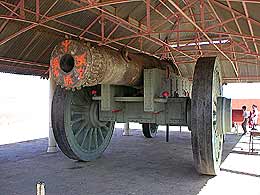 |
It has a range of
20 km It is said that the cannon required 100 kilos of gunpowder to fire
one shot. It was never used in battle. |
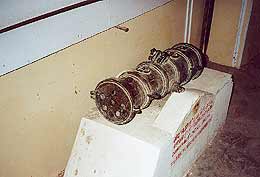 |
The cannon which can shoot six
bullets at once resembles machine gun. |
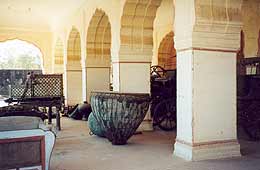 |
Quite big drum in Rajas palace... |
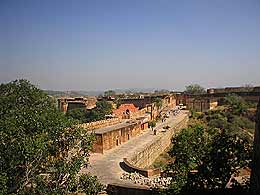 |
The Amber Fort is
11 km northeast of the city going towards Delhi. |
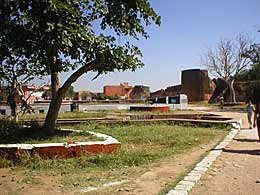 |
White structure in
the middle is huge water tank that served as emergency water source. |
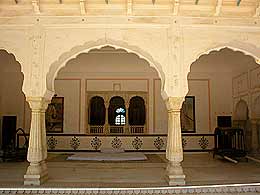 |
There are different
rooms and half open halls, which were used by the king as audience halls
or his private rooms. |
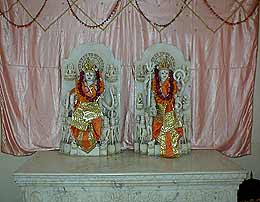 |
Inside the complex
are two temples - Ram-Harihar (10-th century) and Kal-Bhairava (12-th
century). |
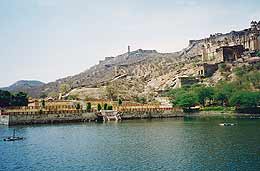 |
The lake and walls help the protection
of the city. |
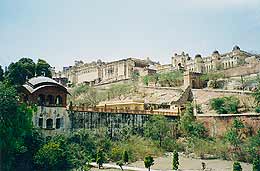 |
To climb up takes about one hour, but it is possible to take a jeep...
|
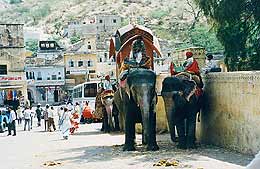 |
...or more stylish
way of transportation. |
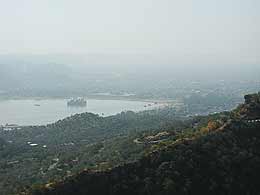 |
Jaipur city from the Western part of the Amber Fort.
|
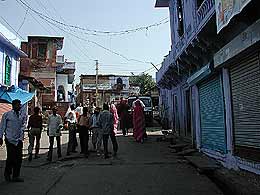 |
Karoli (Karauli)
Karoli is about 182 km southeast of Jaipur and about 100 km southwest
of Mathura. It is a small town and is home to the important Madanmohan
Temple.
|
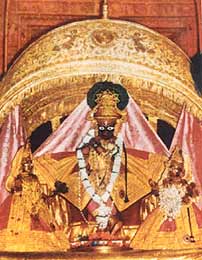 |
Madanmohan Temple
Madanmohan means “one who can even enchant Cupid.” The Deity of Madanmohan
(formerly Madan-Gopal) was made for Krishna's great grandson Vajranabha
and for many years it was lost...
|
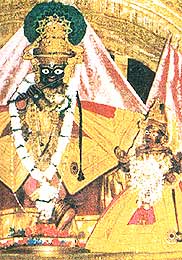 |
...Advaita-acarya found the Deity near Dvadasatiya Hill in Vrindavan
and before His departure for Navadvip He entrusted the Deity to brahmana
Chaubhe in Mathura. Years later Caitanya Mahaprabhu sent Sanatana Goswami
to Vrindavan to discover lost places of Krishna's pastimes and write
books about devotional service...
|
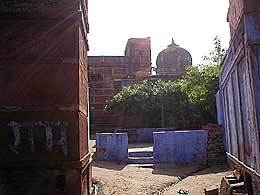 |
...Sanatan used to beg in nearby Mathura and one day came to doors
of the brahman Chaubha. He saw brahmana's children playing with the
Deity as if Madanmohan was one of them. Horrified Sanatan chastised
Chaubha and taught him proper ways of Deity worship. Both Sanatan and
brahman had a dream that night. Madanmohan appeared to Sanatan and told
him, that he liked to be treated as one of the brahmana's children and
since Sanatan introduced so many rules, He don't like it any more...
|
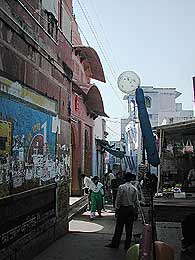 |
...To Chaubha Madanmohan said that he is like one of his children.
He told him that he had many children and he should give Him to Sanatan.
Next morning both devotees wanted to apologize, but at the end Madanmohan
went with Sanatan. But not before He promised to Sanatan that He would
be satisfied with whatever he will be able to offer. Sanatan, being
traveling mendicant could not give much luxury to his Deities...
|
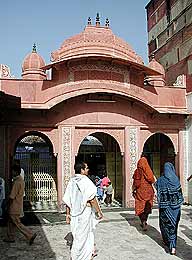 |
...And after some time wealthy businessman build a temple for Madanmohan
that became one of the symbols of Vrindavan.
Entrance to Madanmohan Temple in Karoli (above from outside and
on the left from inside).
|
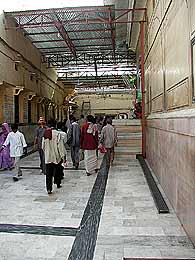 |
...Maharaja Jai Singh brought Madanmohan to Jaipur from Vrindavan.
His brother-in-law, Maharaja Gopal Singh, had a dream in which Madanmohan
said “Take Me to Karoli.” He then told Maharaja Jai Singh about the
dream and asked permission to bring Madanmohan to Karoli. Maharaja Jai
Singh told him if he could distinguish Madanmohan from Govinda and Gopinatha,
the two other main Deities of Jaipur, while blindfolded, then he could
take the Deity. When Gopal Singh was blindfolded, he directly approached
Madanmohan and touched his feet.
|
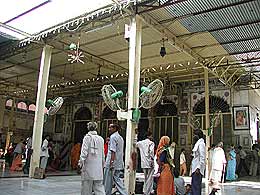 |
In the temple, there are three altars. Madanmohan stands on the center
altar, with Sri Radha on his left and Lalita Devi on his right. On the
left altar is Gopalaji Krishna with Radha and Lalita. The king of Karoli
worshiped these Deities 100 years before Madanmohan came to Karoli.
The Deity receives a midday offering consisting of fifty-six dishes.
Most of the preparations are sweet—malpura, sweet samosas, and other
items.
|
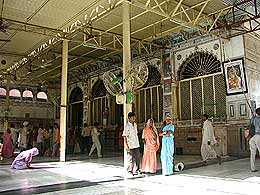 |
To our surprise we paid for prasad in one place, got a ticket and received
prasadam in another one. The man who gave away prasad didn't touch the
money, thus keeping nice hygienic standard.
It is strictly prohibited to take pictures in the temple room and if
one is not careful one's camera may get destroyed... ....but we were
careful enough... :-)
|
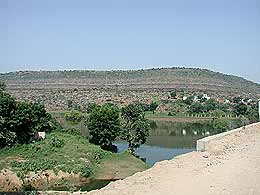 |
Countryside in Rajasthan is more
like desert or semi-desert. The climate is more hot and dry than in other
parts of India. |
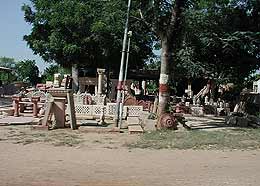 |
Along the roads one can see shops with different parts of houses and
gardens made from red stone from local mines. This stone can keep cool
during hot summer and accumulate warmth during winter. The produce of
local stonemasons can be found on many buildings all around India.
|
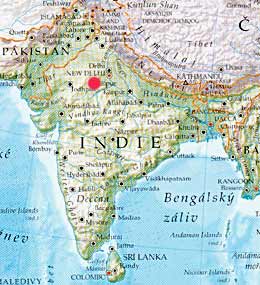 |
|


































































































